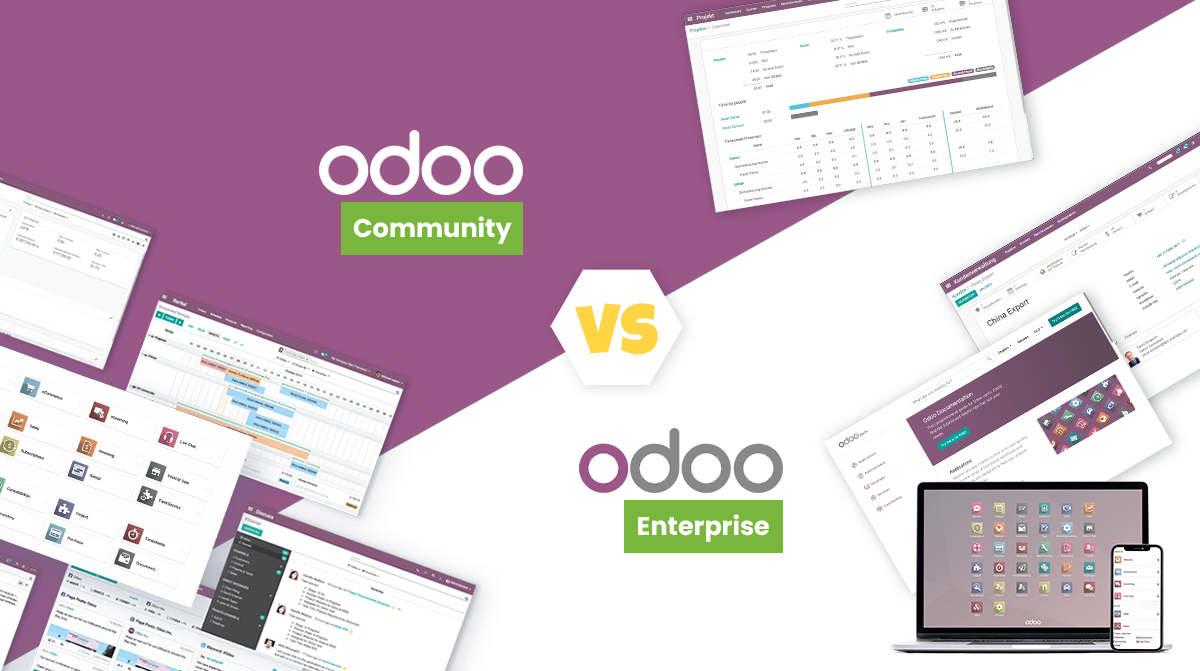Ever wondered the difference between good and the best online shopping stores?
It’s the platform they’re built upon! The platform used to develop an eCommerce store is crucial for its success. Sadly, however, many business owners believe that a good eCommerce store is a costly investment.

But what if we told you that starting your shopping store using Odoo is affordable?
Odoo is the go-to comprehensive and cost-effective ERP for beginners and those new to e-commerce marketing.
But, Why Odoo For Online Store?
Odoo is an open-source ERP that integrates sales, accounting CRM, project management, manufacturing, human resources management, marketing activities, and other business activities in a single software solution.
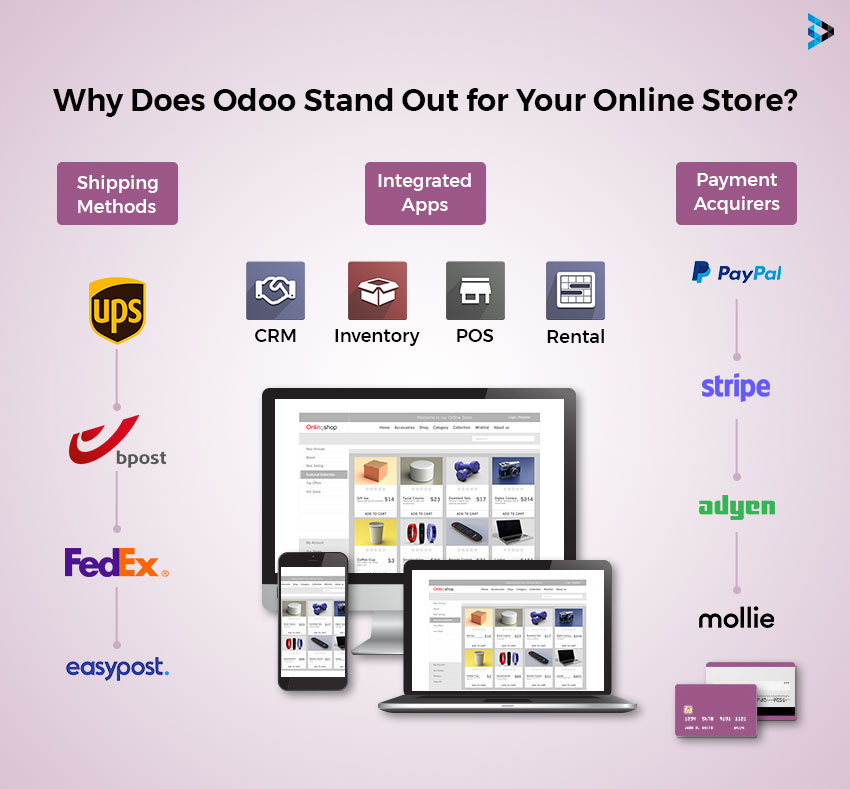
This built-in-cloud modular cloud system offers flexibility to business owners at every stage of their entrepreneurship cycle. Once signed up, you can easily create an online store with multiple functionalities like:
- Open source makes configuration and maintenance straightforward and understandable to the end user.
- The capacity to adapt to the requirements of a certain business.
- All essential business procedures are covered, from placing orders to taking payments and coordinating delivery.
- Interface in several languages.
- A vast number of different modules to ease workers’ jobs and improve user experience.
Considering such unique perks, you might see Odoo as an expensive upgrade. However, that’s not it!
Odoo is a unique opportunity for business owners to start their store using limited investment. Wonder how? Let’s check out as we learn more about it in the following sections.
Decrypting the Basics of Odoo Stores – Tips To Get Started
Much like any other online store, you need to focus on a few crucial pointers to get started with your Odoo online store.
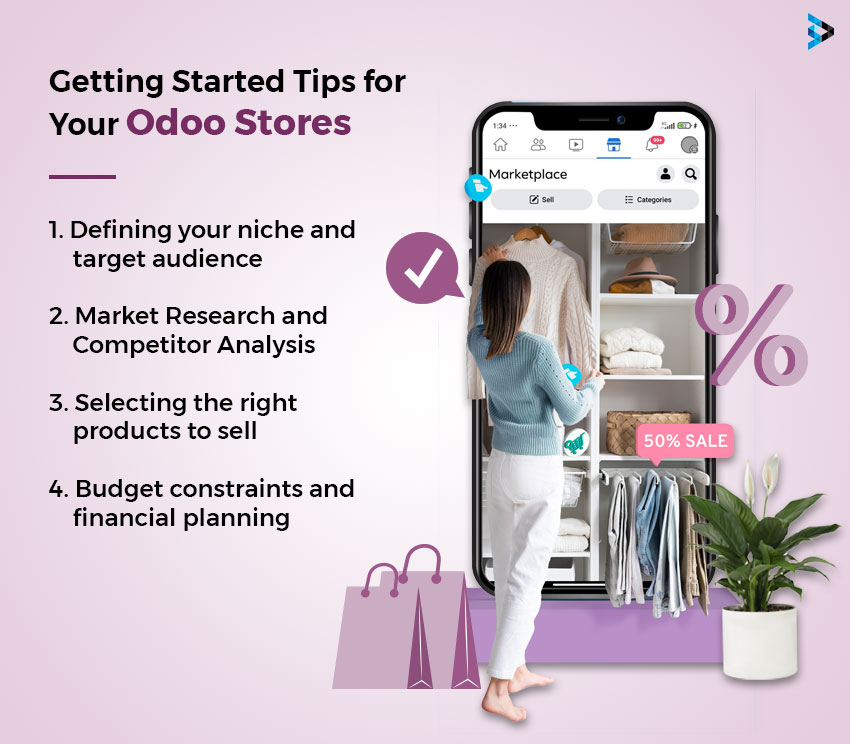
Here are a few factors that you might want to keep in mind while creating a good online shopping store using Odoo:
Defining Your Niche And Target Audience
A niche is a specialised market segment for a particular product or service. Finding and defining your niche helps identify the needs of a particular group of customers should be the #1 goal of your eCommerce development process. These groups of customers become your target audience.
However, while you’re at it, ensure that you identify your target audience and help tailor your marketing efforts to those individuals or entities’ preferences, behaviors, and needs. It involves demographic, psychographic, and behavioral factors to define your ideal customers.
Finding a niche allows you to differentiate yourself from competitors and become an expert in a specific domain.

- Market Research and Competitor Analysis
Understand the broader market and identify potential opportunities and gaps. Niche marketing can provide a competitive advantage by addressing specific needs that broader competitors might overlook.
Identify competitors in your chosen niche and understand what makes you stand out. Study your competitors to identify gaps in the market or areas where you can differentiate your products.
- Selecting The Right Products To Sell
Deciding what products or services to provide is critical and can significantly impact your business’s success, especially when starting a new venture. Determine whether you’ll sell physical, digital, or services.
Ensure that the products you choose comply with local and international regulations. Check for any legal restrictions or certifications required. Also, ensure a stable and reliable supply chain for your chosen products, considering sourcing, manufacturing, and shipping factors.
- Budget Constraints And Financial Planning
Evaluate the production or acquisition costs of the products and compare them to potential selling prices. Ensure that there is enough margin for profit after evaluating the fees of different Odoo services to run your store.
Consider launching a minimum viable product to test the market before investing significantly. Decide your pricing strategy, such as fixed, tiered, or subscriptions.
How Do You Set Up Your Online Store On Odoo?
Select a reliable hosting provider that supports Odoo. Options include AWS, Google Cloud, or specialised Odoo hosting services.
Step 1: Choose a Domain Name
A domain name usually acts as an address for your website or the online store. Every website has its unique domain name. For instance, if you run an online Asian grocery store, you must look for a domain that matches the store’s authenticity.
Step 2: Install and Configure Odoo
Follow the instructions that Odoo provides for self-hosted installations. This might involve setting up a server, configuring databases, and installing Odoo.
Once you have installed Odoo, it’s time to configure. Input your company details, including name, address, and contact information. Set your preferred currency and language.
Step 3: Select and Customize a Suitable Odoo Theme
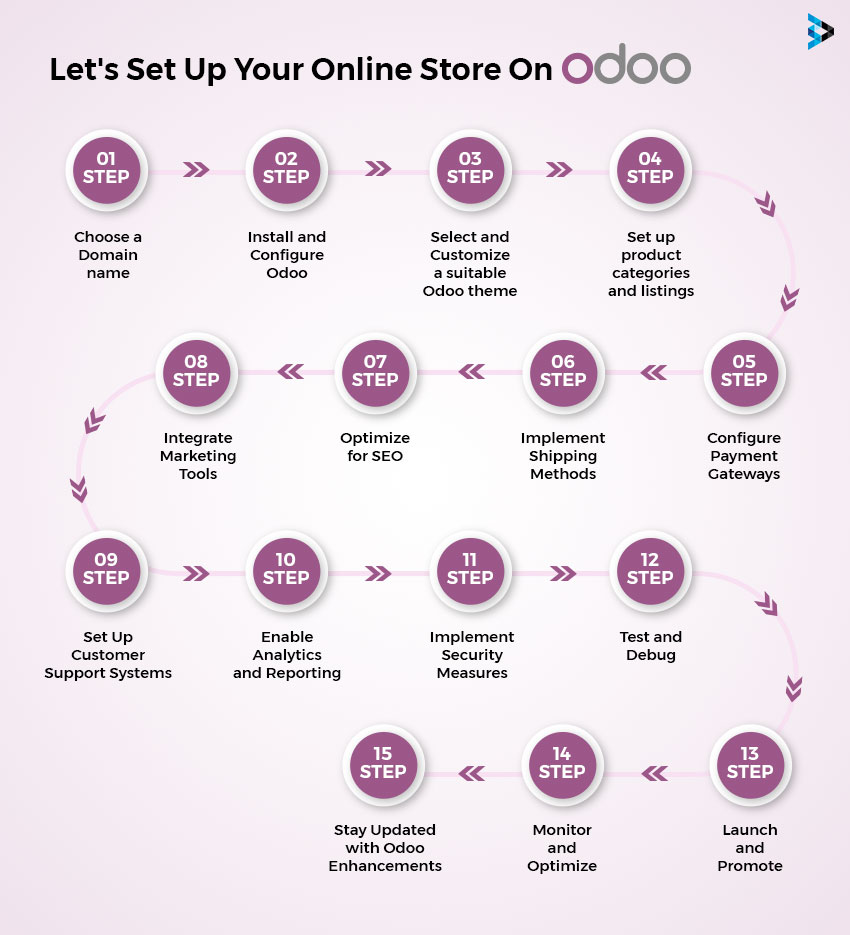
Explore and choose a theme from the available Odoo themes that align with your brand and products. Customize the chosen theme by adding your logo, adjusting colors, and modifying layouts to match your brand identity. Ensure your online store has a user-friendly interface, easy navigation, and clear call-to-action.
Step 4: Set Up Product Categories And Listings
Clearly define the products or services you will offer in your online store. Set up your products in the Odoo system. Include details such as product name, description, pricing, and categorization. If your products have different variants (e.g., sizes and colors), create product variants to manage them effectively.
Inventory Management With Odoo
- Managing Stock Levels
After setting up the product configuration, add the supplier information and establish the price lists for the suppliers to keep track of the costs. Generate a list of orders received based on the stock levels and customer demand.
It would also help if you record the receipt of goods from the suppliers against the purchase orders. Lastly, match the received products with vendor bills for accurate accounting.
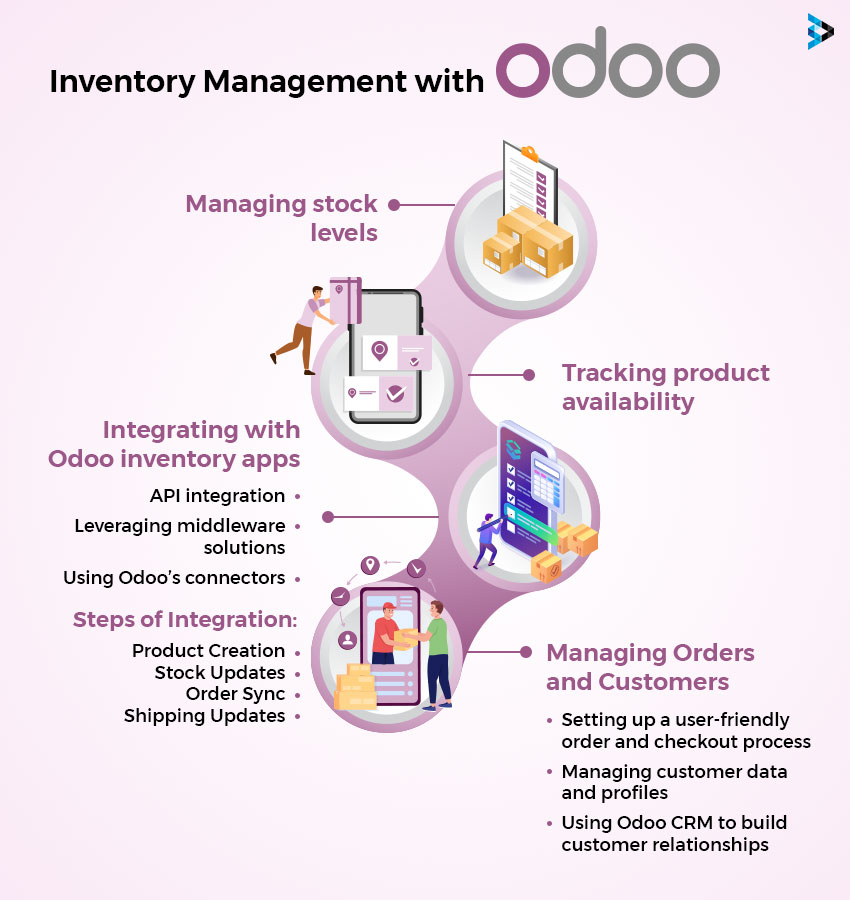
- Tracking Product Availability
- Set up Warehouses and define their physical locations.
- Transfer stock between warehouses as needed.
- Integrate barcodes in your orders for real-time tracking and seamless picking, packing, and shipping process.
- Odoo will provide real-time updates on stock levels, allowing you to make informed decisions.
- Integrating With Odoo InventoryApps
Odoo provides a RESTful API that allows external systems to interact with its modules, including Inventory. You can determine how you want to integrate with Odoo, as there are various options. These options include:
- API integration
- Leveraging middleware solutions
- Using Odoo’s connectors.
The steps of Integration include-
- Product Creation:
Use the API to create new products in Odoo when they are added to your system.
- Stock Updates:
Regularly update stock levels in Odoo based on changes in your inventory.
- Order Sync:
Synchronize orders between your system and Odoo to ensure accurate order fulfillment.
- Shipping Updates:
Update shipping and tracking information in Odoo as orders are shipped.
D. Managing Orders and Customers
Managing orders and customers using Odoo involves utilizing the Sales and CRM modules within the Odoo ERP system. These modules are designed to streamline handling sales orders, managing customer relationships, and tracking interactions.
- Setting Up a User-Friendly Order And Checkout Process
While building your own new online store, make sure that it has an easy and user-friendly interface for the order and checkout process.
- Managing Customer Data And Profiles
- Access the CRM module to create new customer records, which include details such as name, contact information, and any additional custom fields.
- Link the sales and opportunities to specific customers of your organic grocery store online.
- Categorize customers into segments based on location, industry, or purchase history. This categorization is then used for targeted marketing and personalized communication.
- Using Odoo CRM to Build Customer Relationships
Use Odoo CRM to manage sales opportunities and track the progress of potential deals. Odoo CRM lets you log customer interactions, including emails, calls, and meetings. This provides a comprehensive view of customer communication history.
Use Odoo CRM to manage sales opportunities and track the progress of potential deals. The platform’s integrated email marketing tools allow you to engage with customers through newsletters, promotions, and updates.

Payment and Shipping Options
- Integrating Payment Gateways With Odoo
Integrate online payment gateways like PayPal, Stripe, or other regional payment processors by configuring the necessary credentials in the payment acquirer settings.
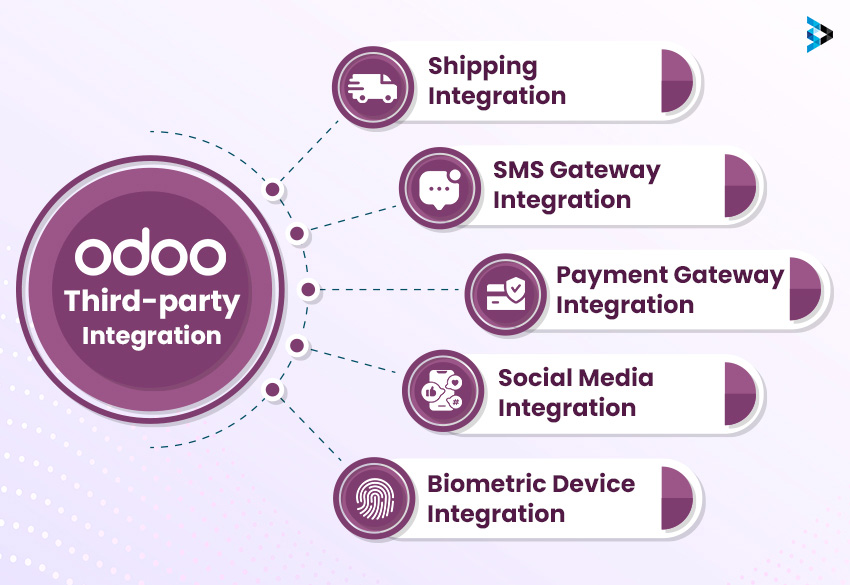
Odoo supports various payment processors, and you can choose the one that suits your business. It also allows you to set up alternative payment methods, such as cash on delivery, bank transfers, or checks.
- Configuring Shipping And Delivery Option
Step 1: Set up delivery methods based on your shipping preferences.
Step 2: Define shipping costs, delivery time, and other relevant details. If you’re using external shipping carriers (e.g., UPS or FedEx), integrate them with Odoo.
Step 3: Set up fixed shipping policies during the CRM Development process. Set up different rules such as free shipping for orders over a certain amount, flat-rate shipping, or custom shipping rules based on product weight, dimensions, or destination.
- Implementing Secure And Reliable Payment Processing
Associate payment methods and shipping options with sales orders. This ensures customers can choose the appropriate payment and shipping preferences during checkout.
Odoo can automate many processes, such as updating stock levels, generating invoices, and confirming sales orders when payment is received. Keep customers informed about their order status, payment confirmation, and shipping updates through automated emails or notifications.
Marketing and SEO for Your Store
Implementing Best SEO Practices
SEO plays a crucial role in boosting the visibility of a webpage. Therefore, implementing the best SEO strategies will help boost the visibility of your page in this competitive market. Some of the strategies include:
- Keyword Research: Conduct thorough keyword research using SEMrush or Google Keyword Planner to identify relevant search terms for your products.
- Optimise Product Pages: Use relevant keywords in product titles, descriptions, and meta tags to optimize each product for search engines.
- Optimize Images: Compress and optimize product images for faster loading times. Use descriptive alt tags with relevant keywords.
- Mobile Optimization: Make your online mobile-friendly, as Google prioritizes mobile-friendly websites in search results.
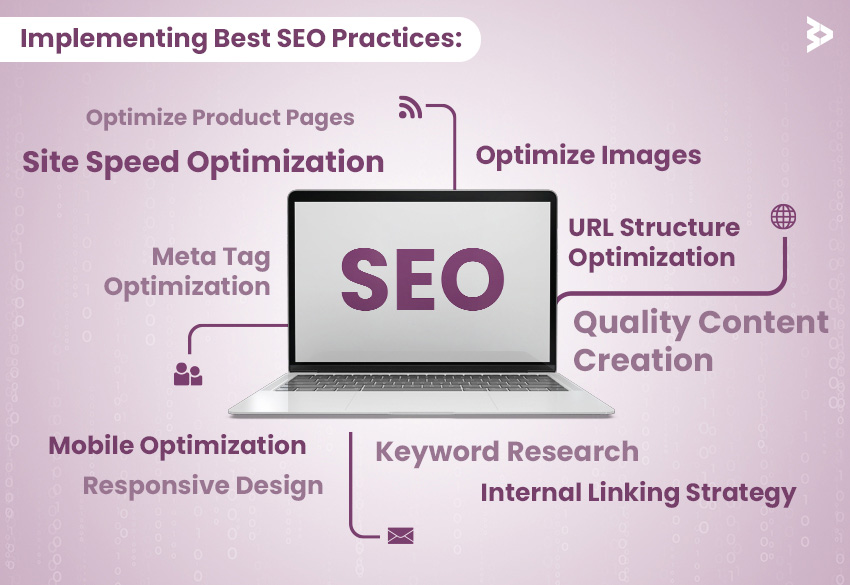
Apart from these strategies, other strategies include improving website speed, building quality backlinks, optimizing meta links, monitoring analytics, and more.
Read more: 8 Benefits Of Technical SEO For Your Website
Creating Compelling Product Descriptions
Create a unique value proposition by highlighting unique features, benefits, or special offers. This will set your online store apart from your competitors.
Develop a content strategy that includes blog posts, product descriptions, and engaging content and provides valuable information about your products or industry.
Utilizing Odoo Marketing Tools
Odoo provides various integrated marketing tools within its ERP, which you can use to raise your position in the search engine.
These tools help businesses automate marketing processes, track campaigns, and engage with customers. Some key features include Odoo email marketing, Odoo social marketing, Odoo SMS marketing, and Odoo live chat.
Cost Management and Return on Investment (ROI) Analysis
Cost management and return on investment (ROI) analysis are crucial to running a successful online business. Odoo, being an ERP system, offers tools that can help you efficiently manage costs and evaluate the performance of your investments.
- Tracking Expenses and Revenue
You can utilize Odoo’s financial modules, such as accounting and invoicing. Regularly input and categorize all the business expenses, which will help you to keep track of expenses, revenue, and financial transactions in one centralized system. This ensures accurate financial records.
- Strategies for Cost-effective Marketing
Some of the strategies for cost-effective marketing include:
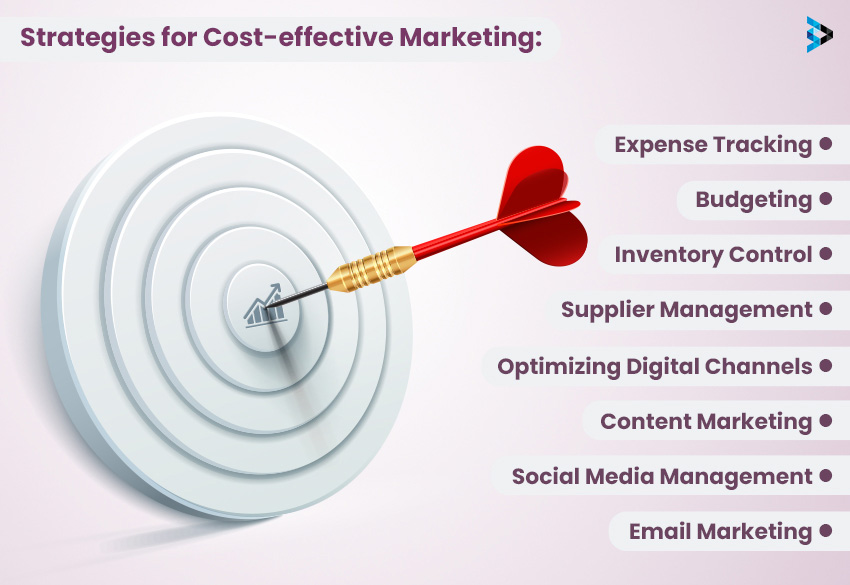
- Expense Tracking: Keeping a close track of expenses allows you to maintain accurate financial records.
- Budgeting: Set up a definite budget, as setting up fixed budgets within Odoo helps plan and control spending.
- Supplier Management: Manage your relationships with suppliers efficiently using Odoo’s Purchase module. Negotiate terms, track purchases, and optimize procurement processes.
- Inventory Control: Use Odoo’s Inventory module to manage stock levels effectively. Avoid overstocking or stockouts, which can impact costs.
- Analyzing ROI
Analyze your ROI, and here are some tips on how you can maximize ROI using Odoo-
- Use Odoo’s reporting tools to analyze sales performance. Identify top-performing products, customer segments, and sales channels.
- Analyze the effectiveness of marketing campaigns using Odoo’s marketing analytics tools. Evaluate conversion rates, customer acquisition costs, and campaign ROI.
- Manage customer interactions, track leads, and analyze customer behavior to improve customer retention and maximize customer lifetime value.
- Monitor employee productivity and ensure that human resources are allocated efficiently to tasks contributing to the business’s success.
Troubleshooting Common Issues During Odoo Development
Troubleshooting common issues in Odoo involves identifying and resolving problems that may arise during the system’s setup, configuration, or usage.
- Addressing Technical Problems
Addressing technical problems in Odoo involves a systematic approach to identifying, diagnosing, and resolving issues.
Odoo provides debugging tools that allow you to inspect variables, trace code execution, and identify issues. Enable the developer mode to access these tools.
- Handling Customer Inquiries and Complaints
Handling customer inquiries and complaints effectively in Odoo involves utilizing its CRM (Customer Relationship Management) and Helpdesk features.
Here are some tips on how you can manage customer interactions effectively-
- After setting up your CRM, ensure the Helpdesk module is installed and activated in your Odoo instance.
- Configure ticketing categories such as “Inquiry” and “Complaint” in the Helpdesk and set up automated routing rules for incoming tickets.
- Integrate web forms on your website to capture customer inquiries directly into the Helpdesk and assign tickets to the relevant teams based on the nature of the issue.
- After resolving customer inquiries or complaints, update ticket statuses as the issues are addressed.
- Lastly, develop a knowledge base in Odoo with FAQs, troubleshooting guides, and standard solutions. You can also refer customers to relevant articles to empower them to resolve simple issues independently.
- Continuous Improvements and Updates
Try addressing as many customers’ problems as possible and providing newer updates after fixing bugs and improvements.
eCommerce With A Plan = Success
Odoo is a great platform to start your online store on a tight budget! However, like other options, it can only be the best online store builder if it provides you with every option.
While the Odoo software itself is free, you’ll need to consider hosting costs to make your online store accessible on the internet. Odoo has a basic set of features; you can enhance the functionality or appearance of your online store with themes and add-ons.
Some may be free, but others may come with a price tag. There may be associated costs if you opt for the enterprise version or require additional support, training, or consulting services. Odoo provides paid services for these purposes.
But you must remember that the success of your online story entirely depends on the quality of the product or services you provide, customer service management, and interaction and marketing efforts.
Read more: 12 Best ERP Software For Manufacturing Industry In 2023!
FAQs
Building the best online shopping store involves careful planning, attention to detail, and effective tools and strategies. But the basics include defining your niche and identifying your target market and audience, choosing a reliable e-commerce platform, building a responsive design with a user-friendly interface, proper inventory management, secure payment gateways, and more.
Odoo is an open-source suite of integrated business applications with a built-in e-commerce module that allows you to create and manage your online store easily. As an open-source solution, Odoo’s community edition is free to use, which can significantly reduce the initial investment compared to proprietary solutions.
Odoo Partners provides various features like inventory management, options for customization, holistic solutions for inventory management, customer relationship management, and more.
Making your online store visible is crucial for attracting potential customers. You can increase your store’s visibility by effectively utilizing search engine optimization, such as using relevant keywords, meta tags, and descriptions. You can also use different marketing strategies like social media marketing, email marketing, content marketing, online advertising, and even collaborations with influencers.
The most important feature that makes Odoo a good choice for entrepreneurs on a budget is its open-source and free use. Other features include a modular architecture integrated suite, eliminating the need for multiple software. Odoo also has features of community support, SEO Optimization, scalability, maintaining analytics and reporting, and more.
Building an online organic grocery store involves several steps, from planning and sourcing products to setting up an e-commerce platform.
Odoo is an open-source enterprise resource planning (ERP) and customer relationship management (CRM) software suite. It offers a free community version that you can use to create an online store.
There are two versions of Odoo- Odoo Community and Enterprise Edition. The community version of Odoo is free and open source, but it has limitations compared to the enterprise version. The enterprise version offers additional features and support but comes with a cost.
The Odoo Website module lets you customize your product catalog on the company website to suit your business requirements. You can easily manage various operations with its advanced customization features.
To customize your website catalog, go to the “Customize” tab. The product catalog displays all your products on the dashboard’s Shops page. It’s easy to find specific products using the search option, making navigation through the catalog quick and simple.
Odoo supports integration with various payment methods for your online store. The specific payment methods available may depend on your location, the version of Odoo you are using, and any additional third-party modules you have installed. Payment methods like PayPal, Stripe, Adyen, etc are common.
Transaction fees for online payments are typically charged by the payment gateway or processor you choose (e.g., Stripe, PayPal). Odoo does not charge transaction fees for payments made through your online store.
Related Articles
-
Why Deploy Odoo as a Docker Container?
Solomon Hykes founded Docker in 2013 with an aim to make containers easy to use. With the introduction of Docker 1.0 in June 2014, the buzz has only become louder.
-
What does the Newest Version of Odoo 14 Offer
Odoo releases a new version every year, and this year being pandemic-ridden, as we all know the version roll-out was an online event. Right after the launch of Odoo 13
-
Odoo Community or Enterprise: Which Offers the Best Value for Your Company?
Many advantages are found in both Odoo Community and Enterprise editions. The Community Edition is ideal for start-ups and small businesses because it is open-source and accessible and has basic




